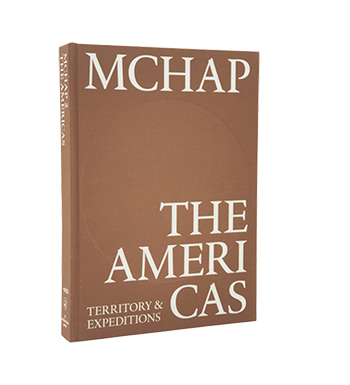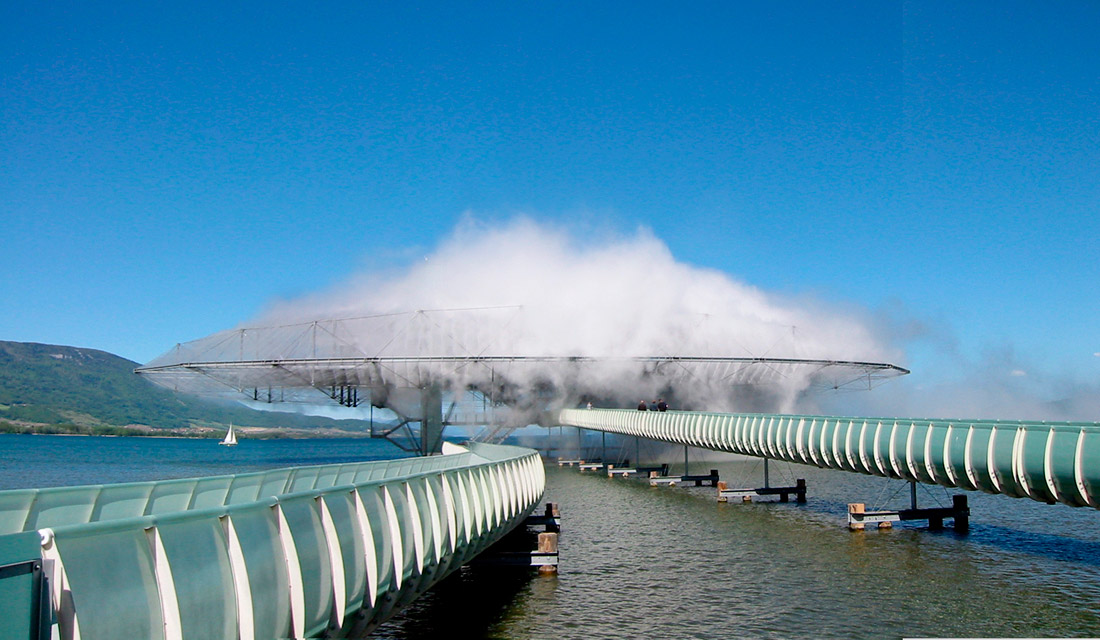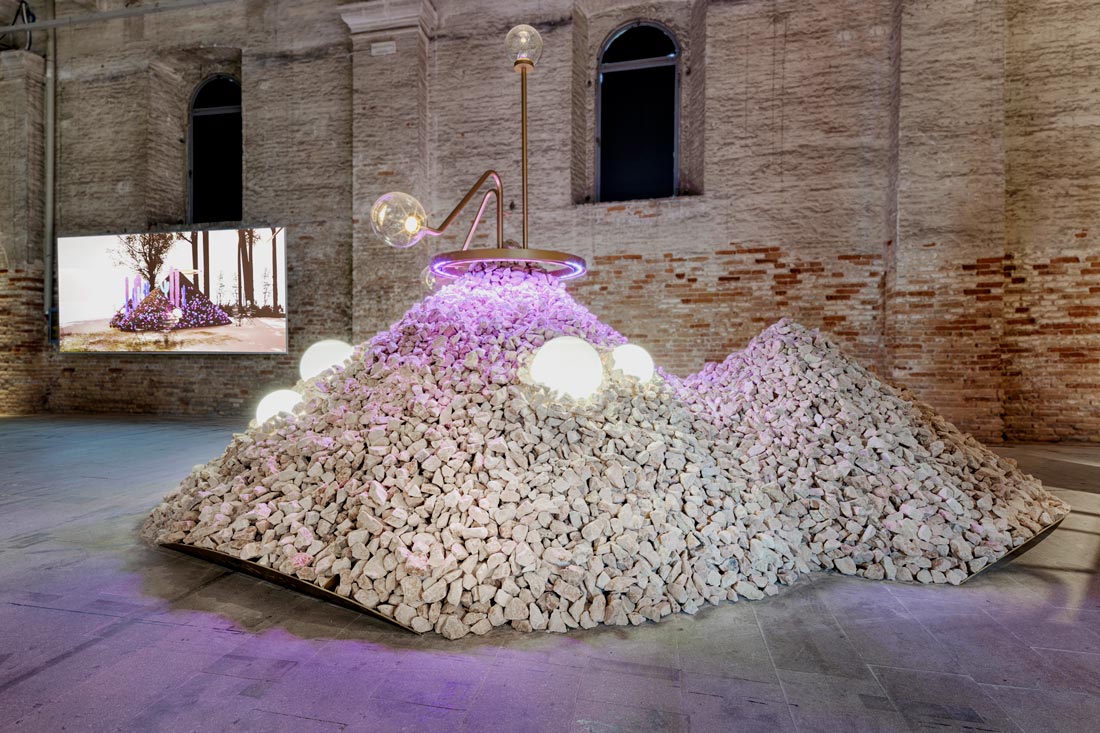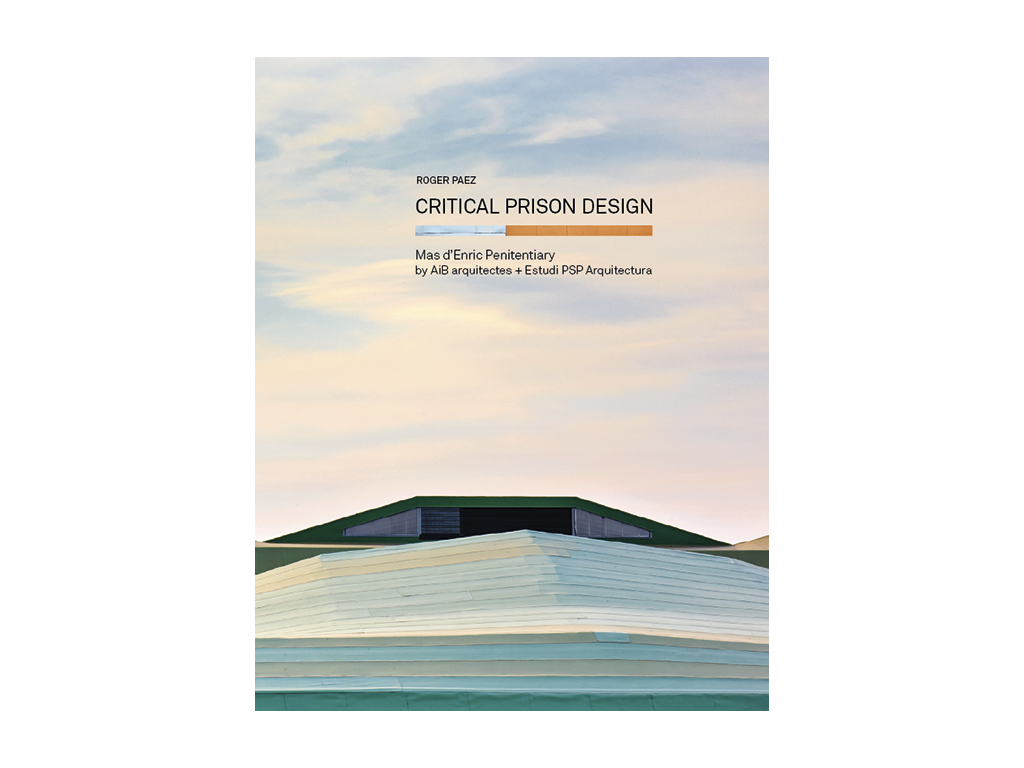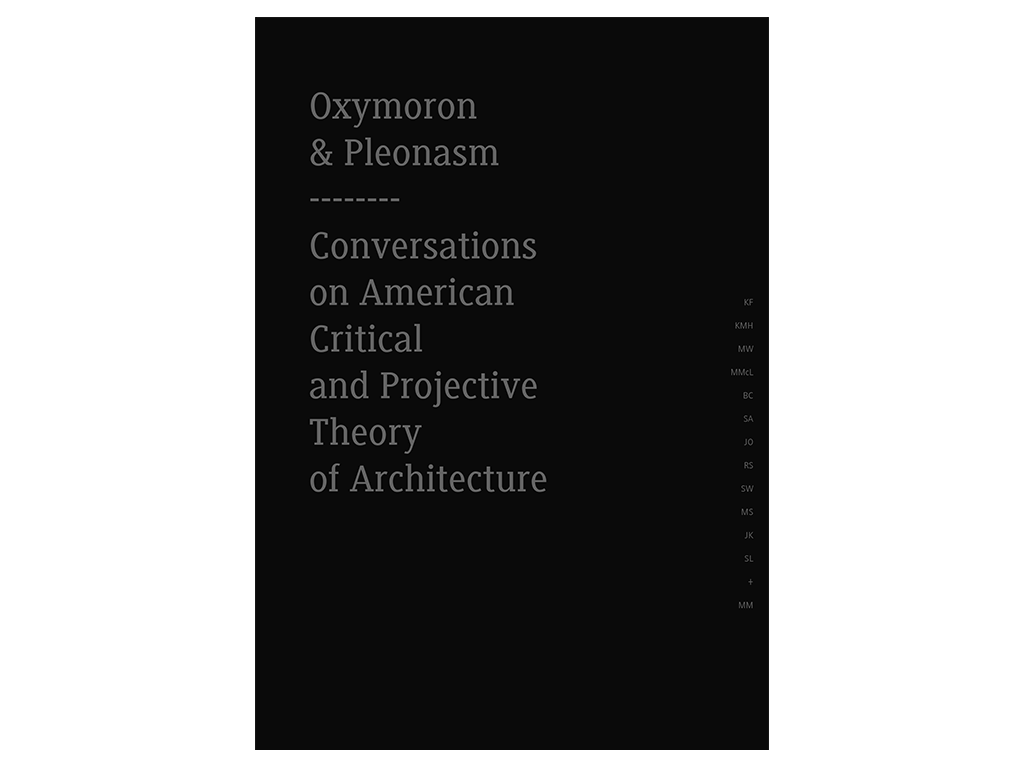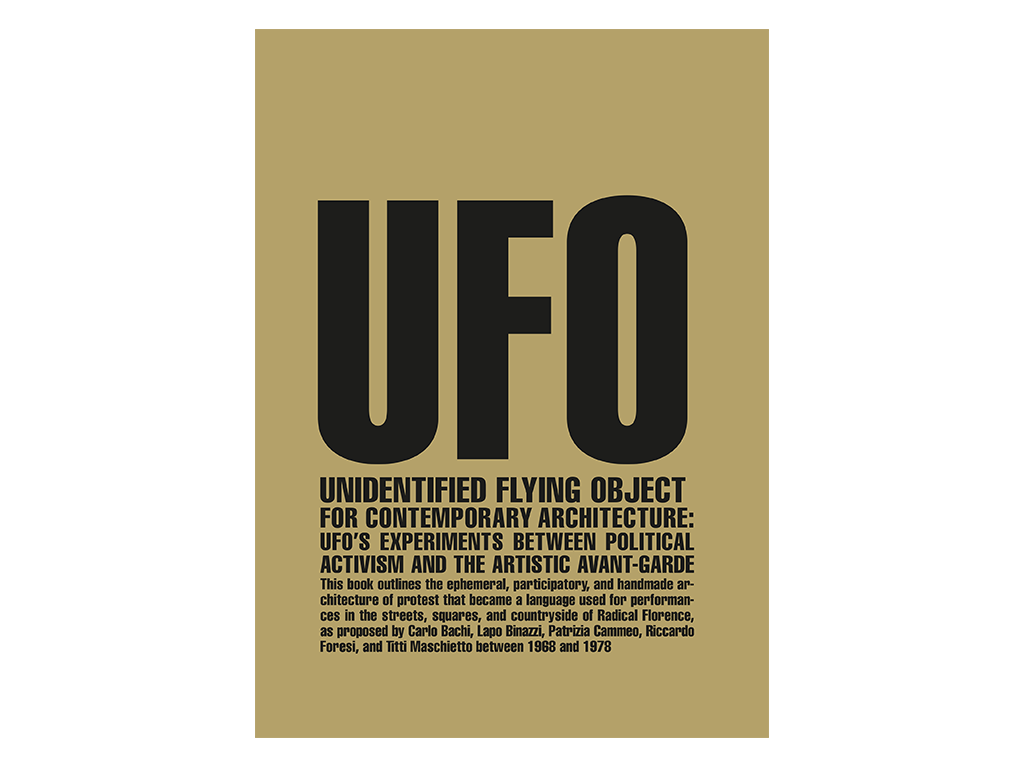Architecture has maintained an oddly consistent relationship to notions of nature throughout history. Nature is assumed to be muse and metaphor to architecture. Fast-forwarding through history, consider Vitruvius’s 1st century treatise De Architectura that celebrated “the truth of nature” as inspiration to architecture.[1] Or, consider Laugier’s 1755 allegory Essai sur L’Architecture on the primitive hut composed from nature as an origin story of architecture embodying simplicity and purity.[2] And more recently, consider mathematical biologist D’Arcy Wentworth Thompson’s 1917 On Growth and Form, which served as an inspiration to early generative and computational architecture in the 1990s.[3] These are only a few examples that illustrate the envy by which architecture emulates, references, or adopts aspects of nature. However, as notions of nature have expanded to become increasingly complex and multivalent, architecture’s previously singular understanding of its relationship to nature has shifted. In what way have social attitudes toward nature marked and informed architecture’s complex relationship with nature today?
While notions of nature have historically provided a powerful and symbolic conceptual partner to design, recent assessments of nature consider it a threat to the stability of architecture. In fact, much of the celebrated technical progress in architecture’s materials and detailing since 20th-century modernism relates to developments in environmental control protecting an arguably stable interior from an unpredictable exterior. Advancements in glazing, sealing, insulation, membranes, and material durability are among the celebrated triumphs of architecture over nature. This position articulates a perception of architecture as defending itself from nature and its environment. Be it atmospheric or biological matter, nature is a risk to building performance, destabilizing architecture’s desire for environmental control. Architecture environmental success is often measured by the efficacy with which it controls separation from the exterior. Only in limited, managed ways is nature permitted to comingle with the building—through operable windows (with bug screens), air intakes (with filters), rainwater management (with filtration system), and indoor plants (in pots), among them. As this agenda unfolded within late modernity, the role of nature in architecture became charged in a complex balance between serving as metaphor, as perpetuated historically, and offering managed climatic collaboration, as introduced in modernism. How is this relationship negotiated today, and what might new understandings of nature offer to the discipline and practice? A current stocktaking of its relationship with nature reveals these complex pairings:
1. Architecture is increasingly technologically guided; Architecture mimics nature as a muse.
2. Architecture contributes to climate change; Architecture is regulated with sustainability policies.
3. Architecture creates interior climates; Architecture hopes to resist exterior ruin.
4. Architecture hosts nature in its interior; Architecture displaces nature on its exterior.
From these dichotomies, there is little evidence that the field is destined for a stable relationship with nature. It is likely to remain fluctuating, with ever-shifting positions in response to disciplinary interests and societal “matters of concern.”[4] However, could a broader understanding of nature as an architectural element offer a more relevant model for contemporary design thinking? Could nature be repositioned as a design matter in architecture?
Blur Building. Courtesy of Diller Scofidio + Renfro.
Posthumanism Turn
A defining attribute of architecture, generally, is that it is anything but nature. Despite passionate metaphors, inspired imitations, and technical mimicry of nature, architecture is manufactured and assembled by humans for a specific human purpose. Similarly, some theorists and practitioners have also argued that nature itself is manufactured by and for humans, even more so today with advances in bio-engineering and georgic-modification. It is this expansion of the notion of nature has broadened the means by which architecture interacts with nature. Observing current positions in the field’s sister discipline of landscape architecture suggests that even it no longer considers pure nature as an aspirational design muse. Instead systems ecology, resilience, and infrastructure serve as contemporary models in landscape architecture. Beyond the mantra of nature as metaphor or nature as material, some contemporary practitioners and theorists have sought out a third way: nature as architectural matter. This is not to argue that architecture is identified as a natural element, but that nature is considered as co-equal within other built matter, such as space, materials, or environment. With this third way comes the potential destabilization of architecture’s human bias, which broadens the understanding of nature in architecture in two ways: the biological and the atmospheric. A consideration of recent interest in posthumanism will be relevant to these understandings.
American philosopher Cary Wolfe’s 2009 book, What is Posthumanism? characterizes the divergent positions of posthumanism as sharing the foundational premise of the “decentering of the human.”[5] His broad overview surveys theoretical as well as cultural and artistic practices, including architecture among film, poetry, and music. In the chapter titled “Lose the Building,” Wolfe observes two projects that were controversial at the time: the 2000 Downsview Park competition entries, especially the winning submission “Tree City” of OMA and Bruce Mau, and the 2002 Swiss Expo installation “Blur” by Diller Scofidio + Renfro. He cites both as emblematic of understanding how to “think anew the relationship of nature and culture.”[6] He identifies a radical condition within these projects, of an architecture subsumed by nature to the degree to which there was no building, just nature. For instance, Wolfe cites Blur as “an imitation of nature that formally renders the impossibility of an imitation of nature.”[7] Instead, the formlessness of Blur realizes the possibility of nature as architectural matter. Nature, in this case as atmospheric material, is equivalent to space, rooms, or walls. While the Blur project is positioned by DS+R as a work of “media,” it also calls upon a posthumanist agenda in its integration of a climate, complete with weather and atmosphere, as an inhabitable space. With a similar absence of building, Tree City offered a park with an incremental process in which “vegetal clusters rather than new building complexes will provide the sites identity.”[8] Nature is architectural matter.
What might be useful to reflect on from Wolfe’s observations is that the two projects he highlights as representative of posthumanism in architecture represent two qualifications of nature: the climatic-atmospheric (Blur) and the biological-animal (Downsview Park) element. While it would be suspect that these two projects alone could embody architecture’s turn toward posthumanism, there has been more recent substantive evidence that the field’s relationship with nature is even more complex than in previous eras. The writing and theoretical positions of Keller Easterling, David Gissen, Catherine Ingraham, and the work and practice of Ants of the Prairie, cero9, R&Sie, Weathers, among others, provides a rich parallel to more conventional notions of architectural sustainability. An interest emerges in these thinkers and practices that is equal part posthumanist in terms of subjectivities, and post-sustainable in terms of technologies. Joyce Hwang, as Ants of the Prairie, courts animals as clients. Cristina Diaz Moreno and Efrén García Grinda, as cero9, use energy systems to construct “another nature.”[9] The work of Weathers, run by Sean Lally, is invested in the spatial potential of gradients in the design of energy and climate in architecture.[10] And, finally, the elusive practice R&Sie are interested in architecture’s response to marginal and deviant natures, such as dust or mosquitos.[11] These contemporary architects identify nature in how it produces new subjectivities beyond instrumentality and beyond the human, and see atmospheres, animals, energy, and climate as raw design matter. This produces an architecture that invites nature to participate and collaborate in its making, and which celebrates the posthumanist realm within design. While the narrative of architecture and nature for this young 21st century has predominantly been oriented toward sustainability, posthumanity in architecture offers an emerging counter-narrative. Rather than seeking an ideal human-approved and human-measured “sustainable” environment, this counter-narrative suggests that architecture and nature produces other environments.
Other Environments
Caught between architecture and nature are shifting notions of and attitudes toward the environment. The contemporary complexity of environment is productively situated within the purview of both architecture and nature. In nature, environment implies the nuanced immediate world to which nature responds. Theoretical biologist Jakob von Uexküll and his concept of umwelt, or environment-world, illustrates this understanding.[12] Von Uexküll’s concept of umwelt was used to identify the perception of an animal’s surroundings by filtering and highlighting only aspects that are important to it. Environment-world reveals an edited nature. In architecture, environment-world might refer to either a climate-controlled interior or the climate of the exterior. Architecture’s umwelt includes both the environment within and around a building. Design attitudes and approaches to these environments in architecture are often reflected in the social attitudes toward nature. This, in turn, establishes an environment-world. Roles and perceptions of nature and environment operate in parallel within design. For example, nature in late modernity offered architecture a validating alibi as genius loci.[13] As innovations in climate-control on the interior, and environmental control at the exterior envelope were developed, architecture sought out a controlled consistent atmosphere in contrast to unpredictable exterior environments. This tendency is encapsulated in the colloquial phrase “the great indoors.” However, rather than accepting a singular understanding of an environmental ideal in architecture, one oriented exclusively toward human comfort, an alternate understanding of nature broadens the acceptance of “other” environments. Other environments are inherently posthuman, in that they don’t necessarily seek out an ideal conception of comfort. These other environments arise in response to the modern bias of a “well-tempered” environment.
Reyner Banham’s Architecture of the Well-Tempered Environment (1969) ushered in a novel and radical understanding of environment in late modernism. Banham’s observations on the “well-tempered” environment exposed the intertwined history of environmental management technology and modern architecture.[14] He highlighted the role of the mechanical to achieve idealized atmospheric qualities while accepting the strict aesthetics of modern architecture. Bahman recognized the heroes of this balance as Louis Kahn’s Richards Memorial Laboratories in Philadelphia (1961), the Architects Division’s Queen Elizabeth Hall, London (1967), and Studio Piano & Rogers’s Centre Georges Pompidou in Paris (1977). These projects balance the modern aesthetic with their mechanical capabilities and integrate their expression as “exposed power.”[15] Banham also observes that in “freeing architecture from local climatic constraints mechanical environmental management techniques have given carte blanche for formal experimentation.”[16] This reveals another form of power, the power of architecture to overcome local climate with a manufactured managed interior climate. Banham’s revelations on modern architecture’s embrace and dependence, and ultimately integration, of mechanical innovations was a visionary re-reading of modern architectural history. However, technical advances and socio-cultural positions on manufactured environments have expanded and deepened in the ensuing five decades. Maybe architecture has been too subservient to its well-tempered environment. Since Banham, architecture’s relationship to environment has been able to suggest many other environments besides a single well-tempered one.
These other environments embody a contemporary unsettled understanding of environment and nature in architecture. David Gissen’s Subnature: Architecture’s Other Environments (2009) highlights a minor narrative within contemporary architecture of the suppression of select natures. If modern architecture had Banham’s “well-tempered” environment, then contemporary architecture has Gissen’s “subnature.” As with Banham’s desire to expose the unwritten history of mechanical and environmental control within modern architecture, Gissen seeks to expose the unwritten condition of minor natures within contemporary architecture. Subnature offers an opening for the acceptance of less desirable, yet inevitable, biological and atmospheric matter. Gissen’s subnature seeks to recover “denigrated forms of nature” and his theory attempts to identify “a new material-aesthetic between architecture and nature.”[17] This includes dust, debris, exhaust as airborne matter, dankness, puddles, mud as watery matter, as well as insects, pigeons, and crowds. Architecture should acknowledge previously considered minor natures. While typically seen as environmentally undesirable and even atmospherically unhealthy, the subnatural is inevitable. Arguably, the emergence of subnature is nature’s response to architecture as an unnatural matter. Gissen elucidates that subnature “supports the notion that architecture and the environment are produced simultaneously.”[18]
To consider architecture’s relationship to nature redirected under the influence of posthumanism and inclusive of other environments, it would benefit to consider four realms in which architecture and nature seem to come into contemporary conflict: climates, ruins, nature outside, and nature inside. These territorial disciplinary concepts will be expanded upon in relation to new notions of nature in architecture.
Climates / Ruins
Climate serves a primary role in the complex larger relationship between architecture and nature. Mid-20th century cultural movements in environmentalism and technological innovations celebrated a vision of architecture better integrated with climate. Architects could “solve” climate problems with design innovation and technology that embraced nature. Architectural visionary Buckminster Fuller popularized this promise through his contributions to energy efficiency in design, or “synergetics,” with the belief that he wasn’t “trying to imitate nature, I’m trying to find the pencil she’s using.”[19] Fuller’s engineered architecture sought to create climates at multiple scales, and he considered architectures interior and exterior responses to climate equally. Most notable to this discussion is Fuller’s sustained belief in the dome as an efficient spatial enclosure. Arguably, the dome embodies an umwelt in its own right. Others at the time, such as Victor Olgyay, posited an analytical approach to “climate management” as a precondition for architectural design.[20] An important illustration in Olgyay’s study was the bioclimatic chart that visualized an ideal “comfort zone.” It is a playfully represented quantitative chart featuring an illustration ofa recumbent person reading with labels hovering at the perimeter of this zone, indicating areas on the chart as “too dry,” “too humid,” “shading needed,” or “sunshine needed.”[21] The bioclimatic chart illustrates the factors that influence the sought-after, idealized climatic condition. Meanwhile, in terms of energy innovations, prototype solar houses, such as Eleanor Raymond’s Dover Sun House, developed at MIT, or George Keck’s “House of Tomorrow,” imagined climate-responsive modern architecture using technology at the domestic scale.[22] These priorities, for the most part, have remained the dominant narrative of architectural climate. However, there are today those at the frontier of other notions of climate that would include a wider range of atmospherics and ecologies. Several projects by the design practice The Living, directed by David Benjamin, embody this type of contemporary agenda. For example, The Living’s prototype Amphibious Envelope “re-imagines the insulated glazing unit as a living ecosystem,” which is essentially a curtainwall system with regulated self-cleaning water and a few frogs.[23] Another project, Living Light, provides a dynamic pavilion in Seoul that uses data collection to visualize air quality issues in the city through light. Other contemporary architects, such as Phillipe Rahm and Sean Lally, have also found ways to integrate climate, and its expression, as a design aspect rather than as something that needs to be solved or as an assumed ideal.
In order to represent the atmospheric representations of climate, drawing has even integrated diagrammatic elements, such as flowing vectors or temperature gradients. Gissen has argued that the vector “becomes an animistic force that fuses the urban environment and architectural object.”[24] The descriptive choice of animistic is notable as it positions these vectors as biomatter. This representational practice has expanded to include comprehensive ecosystems, projecting complete cycles of energy and resources. Yet, these vectorial and gradient-based modes of expression are limiting in their participatory possibilities for architecture. They perpetuate a deterministic and scientific bias in architecture’s interface with climate—again, environment as a problem to solve rather than an equal realm to establish an exchange with. For example, architectural thinking about pollution, Gissen argues, could “shift further from ‘curing’ the city of pollution to curating pollution within architecture.”[25]
It is also of interest to consider climate, like environment or nature, as a force upon architecture; something that architecture attempts to resist. An ultimate outcome of climate’s strongest influence is the detrimental overpowering of architecture: the project in ruin. A ruin presents a glimpse of architecture weakened of its climatic defenses and subjected to the reclaiming force of nature. The broad fascination with architecture in ruin—think “ruin porn”—reveals an underlying wonderment of nature’s ability to overcome architecture, to overwhelm and subsume it. Architecture’s mortality is exposed. However, arguably, a building undergoing ruin is architecture in its most direct exchange with nature. It is an architecture consumed by the spasm of a natural event or slow incremental subnatural event. Strangely, architecture as a ruin also expresses its endurance, or lifespan, in the face of various natural forces. Historian David Leatherbarrow and architect Mohsen Mostafavi’s book On Weathering: The Life of Buildings in Time (1993) observes that “in the mathematics of the environment weathering is a power of subtraction, a minus, under the sign of which newly finished corners, surfaces, and colours are taken away by rain, wind and sun.”[26] They posit that architecture never really is complete until it begins its natural wearing down in the face of climatic and environmental forces. For example, the patina process in several metals creates a chemical compound coating when exposed to natural elements. This process is functional but has also acquired an aesthetic interest such as in the frequent usage of corten steel as cladding to marvel at its visual rot. At a larger scale, the full-body of all the design disciplines has been tasked with resilience to climate change. With climate actions occurring from multiple directions—above, below, and beside—the call for resilience is a call for architecture to endure and ward off ruining forces. The potential of resilient design suggests architecture that is inclusive and even collaborative with climate. Architecture that does not endure becomes a memento mori for architects.
Climate has alternately represented a collaborator in the heating and cooling of spaces and a force pulling architecture into ruin. However, this binary eludes other possibilities of curating climates and coordinating ruin. If architecture is accepted to always produce climates, could climate not begin to function as a spatial and atmospheric matter in design, just as structure, light, and materials are accepted in this way? And could the effects and transformation of ruin be integrated into the design process beyond resilience?
‘Shaped Touches’ 2021, by Sean Lally, at the 17th Venice Architecture Biennale. Photograph by Giorgio Lazaro.
Nature Outside / Nature Inside
Equally critical to shifting positions on nature in architecture is the understanding of how nature, as a landscape or ecosystem, is integrated with architecture. Wright famously advised architects who regretted design decisions to cover it in nature. He wryly stated: “The physician can bury his mistakes, but the architect can only advise his client to plant vines.”[27] Wright suggested nature as a cover-up to architecture. This reflected modern architecture’s contradictory position of nature as elevated enough to be a muse or metaphor, but inferior enough to be used to hide mistakes. Differing approaches appear in regard to the management and design of nature at the exterior versus the interior. Nature in the exterior has produced the lawn, the courtyard, and the garden. Nature in the interior has produced the potted plant. Reconsidering nature’s role in surfaces, a more contemporary integrated approach than Wright can be found in the work of Patrick Blanc, a French botanist who has created notable façades composed entirely of plants.[28] Blanc’s 2004 façade work on the Quai Branly Museum, designed with Jean Nouvel, is of particular note. It is 800 square meters of 15,000 plants from 150 species anchored to a thick felt cover. The only exposed non-natural materials are thinly-framed windows.
Architecture’s legacy of associated exterior landscapes includes forays into gardens, lawns, and courtyards. Possessing and manicuring nature associated with architecture is an extension of the mindset of land ownership and property value. Much has been written about the transformation of approaches to these conditions of architecturalized nature. A range of contemporary attitudes emerges; from Aben and de Wit’s The Enclosed Garden on the courtyard building as an architectural typology; to Teyssot’s The American Lawn, which chronicled the importance of highly-manicured landscapes in American civic spaces; to Dixon Hunt’s Cultural History of Gardens in the Modern Age, which documents the evolution of new materials and attitudes in garden-making.[29] The courtyard, arguably the most architectural, provides a room of quarantined nature. It offers a contained oasis of nature, in which it is invited into an interior surrounded by architecture, without entering the building envelope. The courtyard is isolated from its wider territory and has its own Darwinian ecosystem with contributions from the building and its inhabitants. The role of the garden and lawn as landscapes associated with architecture has often been used as a setting for architecture and to again reinforce nature in contrast with architecture.
Even considering the seemingly most minor element of nature in architecture, the potted plant, we find a profound understanding of nature’s role. Within high modernism, potted plants have provided evidence of architecture’s confidence of controlling and choreographing nature. Nature endures as a symbol (the plant) and confined to a tiny sample of land (the pot). Biology is invited to the interior in a managed way, complete with nourishing soil, as both decoration and status within the domestic. The presence of the interior plant, both as literal nature and as symbol of nature, exploits the plant’s “disciplinary ambiguity between horticulture and decoration.”[30] Operating in a manner similar to other mobile interior elements, such as furniture or art, nature can be moved around and placed within almost any space. This ability reinforces a sense of control and domestication of architecture over nature. Notably, the ubiquity of potted plants “create situations that defy our expectations of the roles of the interior and the exterior and, in doing so, encourage us to rethink the distinction between these two spatial categories.”[31] Even in its smallest gesture, nature inside not only disturbs assumptions of interior and exterior as distinct, but even assumptions of nature and architecture as distinct.
Conclusion
Nature as metaphor and muse in architecture will persist as this mode is also reinforced in postmodern creative practices. And nature as quantifiable and scientific alibi toward an ideal spatial condition or design will also persist. But the notion of nature as spatial matter, both biological and atmospheric offers a turn that brings nature in an equivalent position to aspects such as light, space, structure, and material. Reconsidering architecture’s relationship to nature under the influence of posthumanism and inclusive of other environments, climates, ruins, nature outside, and nature inside reveal new notions. Similarly, the introduction of subnature and posthumanism in architectural theory releases nature from the strictures of naturalness. Likewise, it offers a potential naturalness to architecture that had been hiding under modern assumptions and biases. Much as Banham offered an “unwarranted apology” with the observation that “the idea that architecture belongs in one place and technology in another” has had a crippling effect on the discipline, the same could be said of architecture and nature.[32] Architecture does not exist in distinction to nature—architecture exists naturally.
